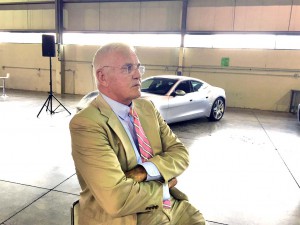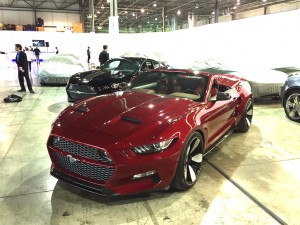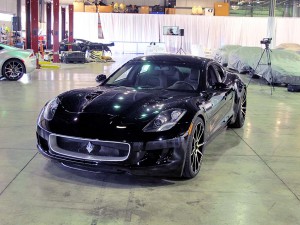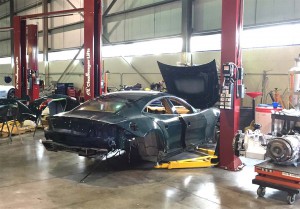
VLF's Bob Lutz discusses the product plans for the new low-volume manufacturer of high-powered performance cars.
It’s hardly the stereotypical image of an automotive assembly plant; just a modest-sized warehouse in the northern Detroit suburb of Auburn Hills, Michigan, a few miles from Fiat Chrysler’s U.S. headquarters. But if all goes according to plan, it will become the home of a small, but highly profitable performance car manufacturer.
VLF Automotive threw open the doors on Thursday evening to a crowd of potential customers – and a handful of media, including TheDetroitBureau.com. And two of the start-up’s top executives laid out their plans and showed off a handful of their new products – while offering a few hints about an even more important model to come.
The key to VLF’s plans: taking basic products produced by other manufacturers, tweaking exterior and interior designs and then stuffing big engines under the hood, all while charging prices that, for the new VLF Destino, can run well above $200,000.
If the name isn’t familiar, that’s because VLF is just starting to get into production. The company was formed in 2012 as a partnership between 84-year-old automotive legend Bob Lutz and industrialist Gilbert Villarreal. Actually, it started out as VL Automotive. The “F” is for Fisker, as in Henrik Fisker, the Danish-born designer who showed his stuff with products like the Aston Martin DB9 – and then had his own start-up, Fisker Automotive, crash and burn in a spectacular 2013 bankruptcy.
Ironically, VLF’s hottest product is the Destino, and if it prods a sense of déjà vu, no surprise. The company is buying up old Fisker Karma plug-in hybrids, stripping out the original drivetrain and replacing it with a Chevrolet Corvette ZR-1-derived LS-9 V-8.
“We’ve basically transformed it into a four-door Corvette,” said Lutz. While he wouldn’t give hard numbers, he suggested it would be only a few tenths slower than the ZR-1 model, which would mean comfortably under 4 seconds to 60 mph, with a top speed “well in excess of 200 mph.”
The VLF Destino also gets some major exterior updates. Indeed, about the only parts carried over from the old Fisker Karma’s body are the windshield, roof and doors. Much of the updated body panels are more of either composites or fiberglass.
Along with the Destino, VLF has taken over production of the Rocket, a heavily modified, 700-horsepower Mustang makeover that Henrik Fisker came up with in a partnership with California mega-dealer Galpin Motors. It will serve as the initial retailer though, as with other VLF models, the goal is to develop a network of exclusive outlets that otherwise represent brands like Ferrari, Lamborghini and Aston.
Product number three is the new Force 1, a rebodied Dodge Viper designed to make well over 700 hp.
VLF delivered the first Destino over the summer and it will hand over the keys to a Force One later this year.
While there’s no shortage of Mustangs that can be turned into Rockets, production of the Force 1 could have a limited run, as Fiat Chrysler has announced it will soon kill off the Viper. And there are only a possible 2,000 or so of Destino’s donor model, the Fisker Karma – though the plug-in model is coming back to life under a new Chinese owner that will be selling it as the Karma Revero.

LF has taken over production of the Rocket, a heavily modified, 700-horsepower Mustang makeover that Henrik Fisker designed.
Lutz said VLF may seek to work with that new company but no discussions have been held yet.
(Fisker Karma makes return as Karma Revero. Click Here for the story.)
Longer-term, the Michigan start-up may become more dependent on the fourth model line it is working up. While Lutz was unusually tight-lipped with details, he hinted it will be, “based on a high-volume model from a major manufacturer, totally transformed into a body style that manufacturer doesn’t offer.”
Villareal, meanwhile, revealed that the car will come in at around $90,000 and, at least initially, will be sold only overseas, as VLF is doing the project for a foreign distributor. But the goal is to eventually market the vehicle in the U.S., as well.
VLF eventually hopes to be selling as many as 1,000 vehicles a year. Even by supercar standards, that’s pretty slim, yet Lutz insisted, “We’re set up to make serious money at extremely low volumes.”
Key to that is the strategy of essentially making over existing vehicles, like the Mustang, Karma and Viper. And while things like the fenders, hoods and decklids will be redesigned, some essential features will remain. Changing things like the angle and dimensions of the windshield start requiring significant engineering efforts – and would create regulatory challenges, so those will remain untouched.
(Click Here to see more about VLF’s delivery of the first Destino.)
VLF also is carefully shopping for things like head and taillamps that can be plugged into its makeovers at a bargain, while not looking out of place.
All told, estimated Lutz, “A project that would cost a major company $300 million, we do it for 5% of that or less.”
It also helps that private equity firm Arctaris has provided some capital to let VLF build up its almost too-lean operations.
“This is a dream job,” said Lutz, who has had plenty of fantasy assignments over the years with automakers including GM, Ford, Chrysler and BMW. “I always wanted to have my name on a high performance car.”
(Lutz, Fisker partner on new VLF Force 1. For more, Click Here.)
He’ll have to settle for just the “L,” but it’s still not a bad way to cap a six-decade career.



Jim Taylor you need to tell the truth. You managed to buy Fisker assets because you promised to look after the customers. And you are shafting all the Fisker customers, by ditching them and forcing them to buy the Karma Revero. It is such a 2-faced approach.
“Stand to make a serious money with extremely low volumes”. I really can’t understand why people think Klutz is this smart auto-exec when he’s always smoke and mirrors. He’s basically selling snake-oil vehicles and I don’t see this getting anywhere, like his vapor-ware Cunningham Car Company.
He came in and ran our company into the dirt, was going to utilize our 36/42V tech in the proposed Cunningham, along with Caddy engineering. Basically pushed, bled and used us, then showed up to Pebble Beach with his stillborn Cunningham and tried to take credit for our work.